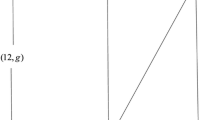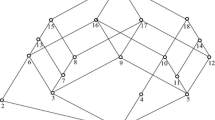Abstract
Knowledge reduction is one of the key issues in formal concept analysis, and there have been many studies on this topic. Granule knowledge reduction and attribute reduction are two of the most important knowledge reduction in formal concept analysis. Firstly, theorem to character granule knowledge reduction is given, and granule knowledge reduction method in concept lattices based on 0–1 linear integer programming is proposed in this paper. Then, characterization theorems of three types attributes are obtained in attribute reduction, and attribute reduction method in concept lattices based on 0–1 linear integer programming is proposed.



Similar content being viewed by others
References
Alcalde C, Burusco A, Fuentes-Gonzlez R, Zubia I (2009) Treatment of L-fuzzy contexts with absent values. Inf Sci 179:1–15
Bělohlávek R (2004) Concept lattices and order in fuzzy logic. Ann Pure Appl Log 128:277–298
Bělohlávek R, Sklenář V (2005) Formal concept analysis constrained by attribute dependency formulas. In: Proceedings of ICFCA 2005. Lecture notes in artificial intelligence, pp 176–191
Cornejo ME, Medina J, Ramirez-Poussa E (2015a) On the use of irreducible elements for reducing multi-adjoint concept lattices. Knowl-Based Syst 89:192–202
Cornejo ME, Medina J, Ramirez-Poussa E (2015b) Attribute reduction in multi-adjoint concept lattices. Inf Sci 294:41–56
Cornejo ME, Medina J, Ramirez-Poussa E (2017) Attribute and size reduction mechanisms in multi-adjoint concept lattices. J Comput Appl Math 318:388–402
Deogun JS, Saquer J (2004) Monotone concepts for formal concept analysis. Discrete Appl Math 144(1–2):70–78
Diaby M (1993) Implicit enumeration for the pure integer 0/1 minimax programming problem. Oper Res 41(6):1172–1176
Fan SQ, Zhang WX, Xu W (2006) Fuzzy inference based on fuzzy concept lattice. Fuzzy Sets Syst 157(24):3177–3187
Ferre S, Ridoux O (2000) A logical generalization of formal concept analysis. In: Lecture notes in artificial intelligence, vol 1867, pp 371–384
Ganter B, Wille R (1999) Formal concept analysis: mathematical foundations. Springer, Berlin
Gong QQ, Zhou YQ, Yang Y (2010) Artificial glowworm swarm optimization algorithm for solving 0–1 knapsack problem. Adv Mater Res 143–144:166–171
Konecny J (2017) On attribute reduction in concept lattices: methods based on discernibility matrix are outperformed by basic clarification and reduction. Inf Sci 415–416:199–212
Krajci S (2005) A generalized concept lattice. Log J IGPL 13(5):543–550
Laskari EC, Parsopoulos KE, Vrahatis MN (2002) Particle swarm optimization for integer programming. In: Evolutionary computation on CEC02 congress 16(6):1582–1587
Li LF (2017) Multi-level interval-valued fuzzy concept lattices and their attribute reduction. Int J Mach Learn Cybernet 8:45–56
Li LF, Zhang JK (2010) Attribute reduction in fuzzy concept lattices based on the T implication. Knowl-Based Syst 23(6):497–503
Li JH, Mei CL, Lv YJ (2011) Knowledge reduction in decision formal contexts. Knowl-Based Syst 24:709–715
Li JH, Mei CL, Lv YJ (2012) Knowledge reduction in real decision formal contexts. Inf Sci 189:191–207
Li JH, Mei CL, Xu WH, Qian YH (2015) Concept learning via granular computing: a cognitive viewpoint. Inf Sci 298:447–467
Li JH, Ren Y, Mei CL, Qian YH, Yang XB (2016) A comparative study of multigranulation rough sets and concept lattices via rule acquisition. Knowl-Based Syst 91:152–164
Liu M, Shao MW, Zhang WX, Wu C (2007) Reduction method for concept lattices based on rough set theory and its application. Comput Math Appl 53(9):1390–1410
Liu X, Wang W, Chai T, Liu W (2007a) Approaches to the representations and logic operations of fuzzy concepts in the framework of axiomatic fuzzy set theory I. Inf Sci 177(4):1007–1026
Liu X, Wang W, Chai T, Liu W (2007b) Approaches to the representations and logic operations of fuzzy concepts in the framework of axiomatic fuzzy set theory II. Inf Sci 177(4):1027–1045
Lv Y, Liu H, J Li (2009) Attribute reduction of formal context based on concept lattice. In: Sixth international conference on fuzzy systems and knowledge discovery, vol 1, pp 576–580
Marinescu R, Dechter R (2010) Evaluating the impact of AND/OR search on 0–1 integer linear programming. Constraints 15(1):29–63
Medina J, Ojeda-Aciego M (2010) Multi-adjoint t-concept lattices. Inf Sci 180(5):712–725
Medina J, Ojeda-Aciego M, Ruiz-Calvigo J (2009) Formal concept analysis via multi-adjoint concept lattices. Fuzzy Sets Syst 160(2):130–144
Ohtake Y, Nishida N (1985) A branch-and-bound algorithm for 0–1 parametric mixed integer programming. Oper Res Lett 4(1):41–45
Ren R, Wei L (2016) The attribute reductions of three-way concept lattices. Knowl-Based Syst 99:92–102
Shao MW, Leung Y (2014) Relations between granular reduct and dominance reduct in formal contexts. Knowl-Based Syst 65:1–11
Shao MW, Li KW (2017) Attribute reduction in generalized one-sided formal contexts. Inf Sci 378:317–327
Shao MW, Yang HZ, Wu WZ (2014) Rule acquisition and complexity reduction in formal decision contexts. Int J Approx Reason 55:259–274
Shao MW, Yang HZ, Wu WZ (2015) Knowledge reduction in formal fuzzy contexts. Knowl-Based Syst 73:265–275
Shao W, Hu W, Huang X (2008) A new implicit enumeration method for linear 0–1 programming. In: International workshop on modelling, pp 98–301
Wang X, Zhang WX (2008) Relations of attribute reduction between object and property oriented concept lattices. Knowl-Based Syst 21(5):398–403
Wang J, Liang J, Qian Y (2010) A heuristic method to attribute reduction for concept lattice. In: International conference on machine learning and cybernetics, vol 1, pp 483–487
Wei L, Qi JJ (2010) Relation between concept lattice reduction and rough set reduction. Knowl-Based Syst 23:934–938
Wei L, Wan Q (2016) Granular transformation and irreducible element judgment theory based on pictorial diagrams. IEEE Trans Cybern 46(2):380–387
Wei L, Qi JJ, Zhang WX (2008) Attribute reduction theory of concept lattice based on decision formal contexts. Sci China Ser F 51(7):910–923
Wille R (1982) Restructuring lattice theory: an approach based on hierarchies of concept. In: Ivan Rival R (ed) Ordered sets. Reidel, Dordecht, Boston, pp 445–470
Wu WZ, Leung Y, Mi JS (2009) Granular computing and knowledge reduction in formal contexts. IEEE Trans Knowl Data Eng 21(10):1461–1474
Xu YT, Wang LS, Zhang RY (2011) A dynamic attribute reduction algorithm based on 0–1 integer programming. Knowl-Based Syst 24:1341–1347
Yang HZ, Shao MW (2007) Two types of generalized variable precision formal concepts. In: Lecture Notes in Computer Science, vol 4585, pp 658–667
Zaki MJ, Parthasarathy S, Ogihara M, Li W (1997) New algorithms for fast discovery of association rules. In: Proceedings of 3rd international conference on database systems for advanced applications
Zhang WX, Wei L, Qi JJ (2005) Attribute reduction in concept lattice based on discernibility matrix. In: Slezak D et al (eds) RSFDGrC2005. LNAI, vol 3642, pp 157–165
Zhang WX, Ma JM, Fan SQ (2007) Variable threshold concept lattices. Inf Sci 177(22):4883–4892
Zhao YX, Li JH, Liu WQ, Xu WH (2016) Cognitive concept learning from incomplete information. Int J Mach Learn Cybern 7(4):1–12
Acknowledgements
This work was partially supported by the National Natural Science Foundation of China (GrantNos. 11401469, 11701446) and the Natural Science Foundation of Shanxi Province (2018JM1055) and Natural Science Foundation of Fujian Province (2016J01310).
Author information
Authors and Affiliations
Corresponding author
Ethics declarations
Conflict of interest
The authors declare that they have no conflict of interest.
Ethical approval
This article does not contain any studies with human or animal participants performed by any of the authors.
Informed consent
Informed consent is obtained from all individual participants included in the study.
Additional information
Communicated by A. Di Nola.
Publisher's Note
Springer Nature remains neutral with regard to jurisdictional claims in published maps and institutional affiliations.
Rights and permissions
About this article
Cite this article
Li, L., Zhang, D. 0–1 linear integer programming method for granule knowledge reduction and attribute reduction in concept lattices. Soft Comput 23, 383–391 (2019). https://doi.org/10.1007/s00500-018-3352-1
Published:
Issue Date:
DOI: https://doi.org/10.1007/s00500-018-3352-1




